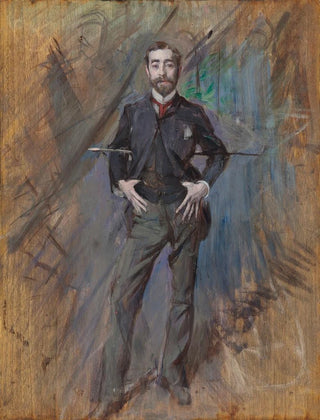Art print | Portrait of John Singer Sargent - Giovanni Boldini


View from behind

Frame (optional)
Portrait of John Singer Sargent - Giovanni Boldini – Captivating Introduction
In the fascinating world of painting, some works stand out for their ability to capture not only the physical appearance but also the very essence of their subjects. The "Portrait of John Singer Sargent" by Giovanni Boldini is a striking example. This iconic piece, created by one of the masters of portraiture in the early 20th century, evokes a meeting between two giants of art. Boldini, known for his flamboyant style and daring technique, manages to immortalize Sargent, another virtuoso of painting, in a moment of timeless grace. This portrait does more than depict a man; it tells a story, that of an era when art and society were deeply intertwined.
Style and uniqueness of the work
Giovanni Boldini's style is unparalleled, and his approach to portraiture is characterized by a dynamism and fluidity that transcend mere visual rendering. In this piece, Boldini uses lively brushstrokes and vibrant colors to bring Sargent's figure to life. The way he plays with light and shadow creates a depth that draws the eye and captivates the mind. Every detail, from Sargent's elegant attire to the delicate background, is carefully orchestrated to create visual harmony. Sargent's posture, both relaxed and confident, reflects his stature as an artist and his assurance in the art world. This portrait is much more than a simple representation; it is a statement about the identity and talent of a man who marked his era.
The artist and his influence
Giovanni Boldini, of Italian origin, established himself on the Parisian art scene at the end of the 19th century and the beginning of the 20th century. His style, often described as "impressionist" in technique but "rococo" in decorative approach, influenced many contemporary artists. Boldini not only captured the elegance of his subjects but also managed to translate the spirit of an era, that of Paris salons, where art and fashion intertwined. His work on John Singer Sargent is not merely a tribute to a compatriot but also a reflection

Matte finish

View from behind

Frame (optional)
Portrait of John Singer Sargent - Giovanni Boldini – Captivating Introduction
In the fascinating world of painting, some works stand out for their ability to capture not only the physical appearance but also the very essence of their subjects. The "Portrait of John Singer Sargent" by Giovanni Boldini is a striking example. This iconic piece, created by one of the masters of portraiture in the early 20th century, evokes a meeting between two giants of art. Boldini, known for his flamboyant style and daring technique, manages to immortalize Sargent, another virtuoso of painting, in a moment of timeless grace. This portrait does more than depict a man; it tells a story, that of an era when art and society were deeply intertwined.
Style and uniqueness of the work
Giovanni Boldini's style is unparalleled, and his approach to portraiture is characterized by a dynamism and fluidity that transcend mere visual rendering. In this piece, Boldini uses lively brushstrokes and vibrant colors to bring Sargent's figure to life. The way he plays with light and shadow creates a depth that draws the eye and captivates the mind. Every detail, from Sargent's elegant attire to the delicate background, is carefully orchestrated to create visual harmony. Sargent's posture, both relaxed and confident, reflects his stature as an artist and his assurance in the art world. This portrait is much more than a simple representation; it is a statement about the identity and talent of a man who marked his era.
The artist and his influence
Giovanni Boldini, of Italian origin, established himself on the Parisian art scene at the end of the 19th century and the beginning of the 20th century. His style, often described as "impressionist" in technique but "rococo" in decorative approach, influenced many contemporary artists. Boldini not only captured the elegance of his subjects but also managed to translate the spirit of an era, that of Paris salons, where art and fashion intertwined. His work on John Singer Sargent is not merely a tribute to a compatriot but also a reflection






